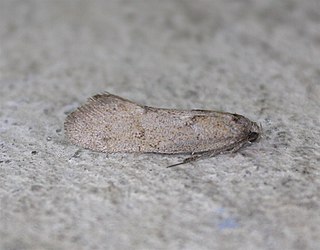
Tingena marcida is a species of moth in the family Oecophoridae. It is endemic to New Zealand and has been observed in Canterbury. Adults are on the wing in September and October.
Stigmella propalaea is a species of moth in the family Nepticulidae. It is endemic to New Zealand. This species is classified as "Data Deficient" by the Department of Conservation.
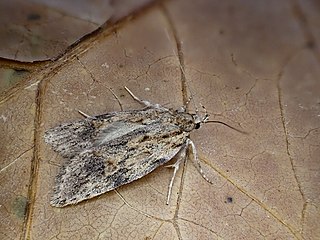
Izatha voluptuosa is a species of moth in the family Oecophoridae. It is endemic to New Zealand. This species is classified as "Not Threatened" by the Department of Conservation.
Izatha dulcior is a species of moth in the family Oecophoridae. It is endemic to New Zealand. This species is classified as "At Risk, Naturally Uncommon" by the Department of Conservation. I. dulcior is the first lepidoptera species described as endemic to the Poor Knights Islands.
Izatha haumu is a species of moth in the family Oecophoridae. It is endemic to New Zealand. This species is classified as "At Risk, Naturally Uncommon" by the Department of Conservation. It is believed to only inhabit the Aupouri Peninsula.
Izatha taingo is a species of moth in the family Oecophoridae. It is endemic to New Zealand. This species is classified as "At Risk, Naturally Uncommon" by the Department of Conservation. It is only known from the Aupouri Peninsula of Northland.
Izatha oleariae is a species of moth in the family Oecophoridae. It is endemic to New Zealand. This species is classified as "At Risk, Naturally Uncommon" by the Department of Conservation. It is only found on the Snares Islands.
Izatha spheniscella is a species of moth in the family Oecophoridae. It is endemic to New Zealand. This species is classified as "At Risk, Naturally Uncommon" by the Department of Conservation. It is only found on the subantarctic Snares Islands.

Izatha caustopa is a lichen tuft moth in the family Oecophoridae. It is endemic to New Zealand, where it is known very locally, and very infrequently, from the southern half of the North Island: two specimens collected in 2016 were the first seen for 30 years. It is classified as "Data Deficient" by the Department of Conservation.
Izatha dasydisca is a species of moth in the family Oecophoridae. It is endemic to New Zealand. This species is classified as "At Risk, Naturally Uncommon" by the Department of Conservation.
Izatha gibbsi is a species moth in the family Oecophoridae. It is endemic to New Zealand. This species is classified as "At Risk, Naturally Uncommon" by the Department of Conservation. It is named for George W. Gibbs.
Izatha minimira is a species of moth in the family Oecophoridae. It is endemic to New Zealand. This species is classified as "At Risk, Naturally Uncommon" by the Department of Conservation.

Izatha rigescens is a species of moth in the family Oecophoridae. It is endemic to New Zealand. This species is classified as having the conservation status of "Data Deficient" by the Department of Conservation. It is only known from the Wellington coast. This species has not been seen since 1929.
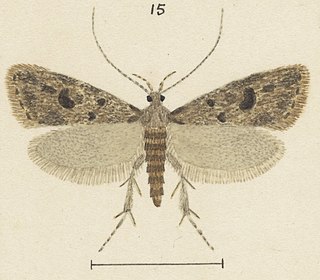
Gymnobathra ambigua is a species of moth in the family Oecophoridae. It is endemic to New Zealand. This species has been classified as critically endangered by the Department of Conservation.

Phaeosaces lindsayae is a species of moth in the family Depressariidae. It is endemic to New Zealand. It is classified as "Data Deficient" by the Department of Conservation.
Hierodoris huia is a species of moth in the family Oecophoridae. It is endemic to New Zealand. It is only known from two sites in Titirangi that are approximately 1 to 2 km apart. H. huia is suspected to be a forest canopy-dweller. This species is on the wing in January. Although the adult moths are attracted to light it has been hypothesised that it is a diurnal species on the basis of the behaviour the species exhibit when light trapped. The species was named in honour of the extinct bird species, the huia, as well as the type locality of Huia Road, Titirangi. This species is classified as "Data Deficient" by the Department of Conservation.
Hierodoris sesioides is a species of moth in the family Oecophoridae. It is endemic to New Zealand and is known from its type locality of Esk State Forest in the Hawkes Bay. The host species is Spohora tetraptera, a kōwhai species. The larvae feed internally in woody galls on the stems of this plant. This species is classified as "Data Deficient" by the Department of Conservation.
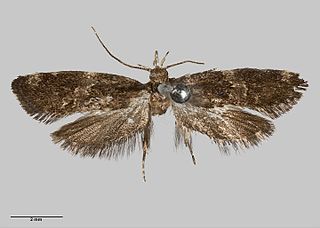
Trachypepla nimbosa is a species of moth in the family Oecophoridae. It is endemic to New Zealand. This species has been collected in Auckland as well as one specimen in the West Coast. Adults are on the wing in January however the West Coast specimen was collected in November. This species is classified as "Data Deficient" by the Department of Conservation.
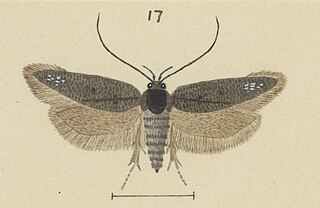
Gymnobathra origenes is a species of moth in the family Oecophoridae. This species is in need of taxonomic revision and it has been hypothesised that it belongs to the family Gelechiidae. The species is endemic to New Zealand. It has been classified as Data Deficient by the Department of Conservation. This species is known from only one specimen.
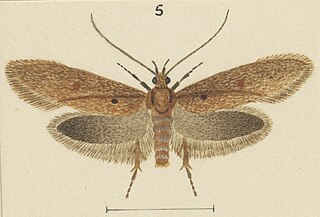
Leptocroca xyrias is a species of moth in the family Oecophoridae. The taxonomy of this species is in need of revision and L. xyrias likely belongs to a separate genus. It is endemic to New Zealand. It has been classified as Data Deficient by the Department of Conservation.








